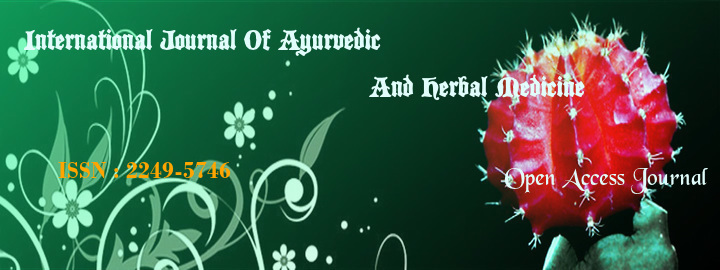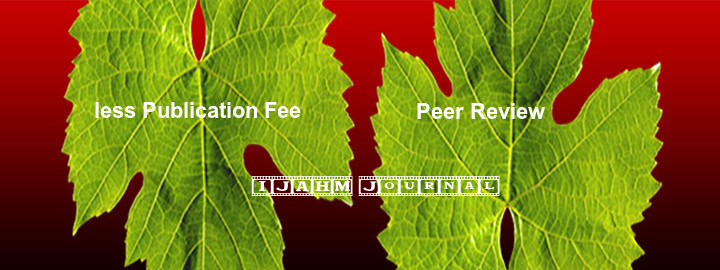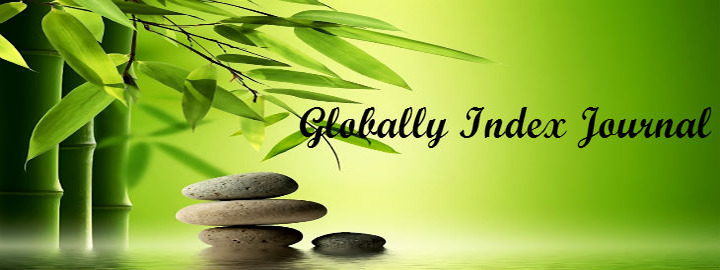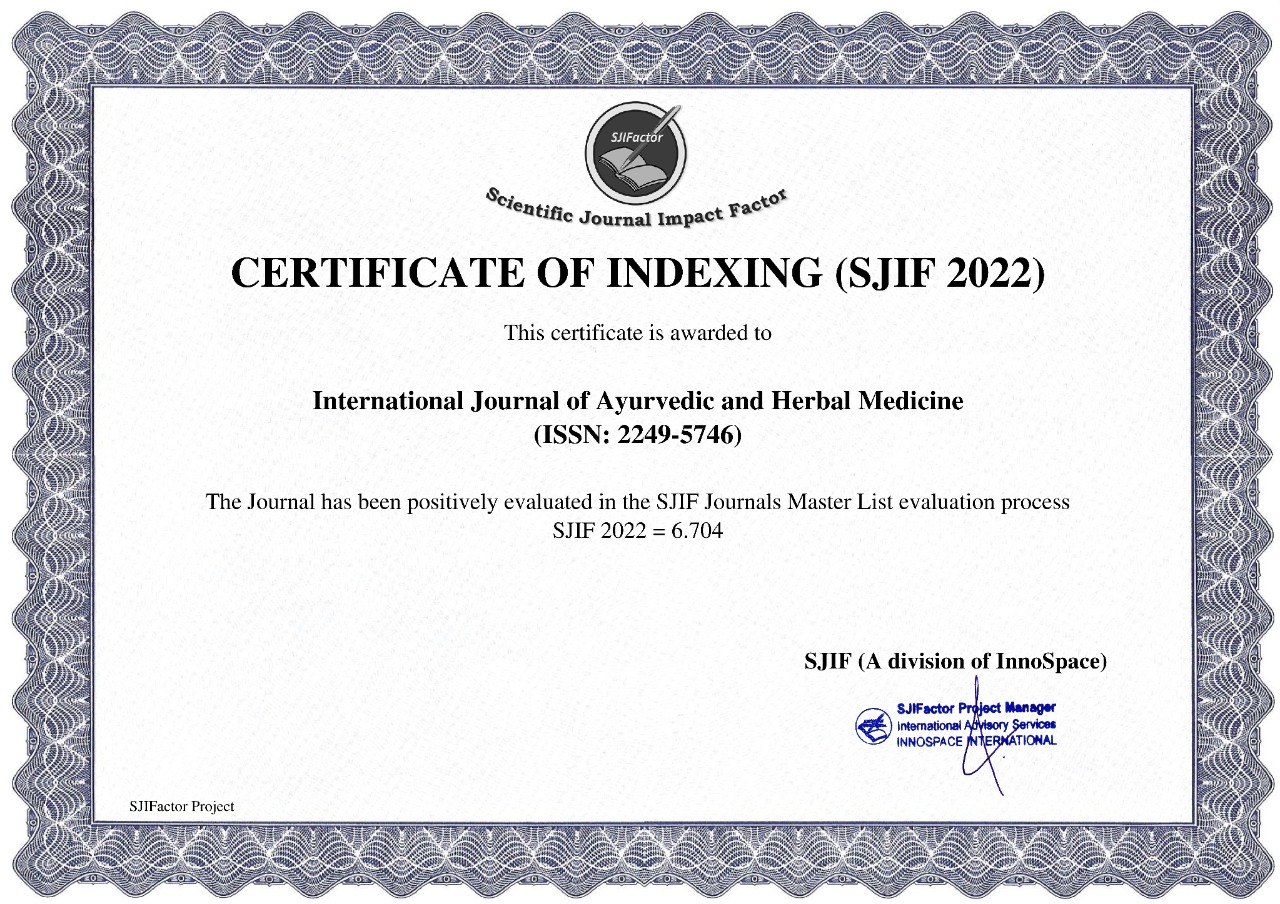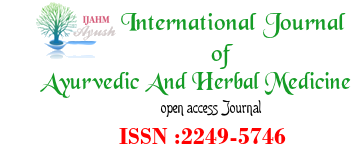


Priyanka G1, 2, Chandrasekhar M1,Kayalvizhi E1, Chinmayi Sri Amulya Y3
DOI : http://dx.doi.org/10.31142/ijahm/v9i3.01
1Meenakshi Medical College Hospital and Research Institute, Kanchipuram, Tamil Nadu, India.
2Ragas Dental College and Hospital, Uthandi, Chennai, Tamil Nadu, India.
3Cancer Biology lab, Molecular and Nanomedicine Research unit, Sathyabama Institute of Science and Technology, Chennai,Tamil Nadu, India.
Correspondence Author: Dr. Chandrasekhar Madhavan
Vice Principal and HOD, Meenakshi Medical College Hospital & Research Institute, Kanchipuram, Tamil Nadu, India
Abstract
Phytochemicals such as alkaloids, flavonoids, pigments, phenolics, terpenoids, steroids and essential oils are a large group of plant-derived compounds commonly found in diets high in fruits, vegetables, beans and cereals. The sample of Maha Vallathy Leghiyam (MVL) was analyzed for their phytochemical compositions, vitamins and minerals constituents. Based on the observed results explored the presence of bioactive constituents comprising flavonoids, phenols. These substances are the main reason for beneficial role against human health related problems, and it is responsible for the anti-inflammatory, antioxidant, antimicrobial, antitumor and anticancer properties. During the present study, we have tested the Antioxidant activity of through DPPH scavenging assay. The phytochemical screening revealed the extract richness in Tannins, Phlobatannin, Saponins, Flavonoids, Steroids and Alkaloids. Antioxidant activity was determined by DPPH radical scavenging assay, in which IC50 values obtained by DPPH activity for MVL aqueous crude extract was found to be 50μg/mL. The obtained results suggest that MVL has promising antioxidant activity and could serve as potential source of natural antioxidants.
Keywords: Phytochemical; metabolites; alkaloids; minerals; antimicrobial property; MVL
REFERENCES
1. Upadhyay S, Dixit M. Role of Polyphenols and Other Phytochemicals on Molecular Signaling. Oxid Med Cell Longev. 2015;2015:504253.
2. Slavin JL, Lloyd B. Health benefits of fruits and vegetables. Adv Nutr. Jul 1 2012;3(4):506-516.
3. Lillehoj H, Liu Y, Calsamiglia S, et al. Phytochemicals as antibiotic alternatives to promote growth and enhance host health. Vet Res. Jul 31 2018;49(1):76.
4. Milugo TK, Omosa LK, Ochanda JO, et al. Antagonistic effect of alkaloids and saponins on bioactivity in the quinine tree (Rauvolfia caffra sond.): further evidence to support biotechnology in traditional medicinal plants. BMC Complement Altern Med. Oct 26 2013;13:285.
5. Mujeeb F, Bajpai P, Pathak N. Phytochemical evaluation, antimicrobial activity, and determination of bioactive components from leaves of Aegle marmelos. Biomed Res Int. 2014;2014:497606.
6. Talib WH, Mahasneh AM. Antiproliferative activity of plant extracts used against cancer in traditional medicine. Sci Pharm. Jan-Mar 2010;78(1):33-45.
7. Alesaeidi S, Miraj S. A Systematic Review of Anti-malarial Properties, Immunosuppressive Properties, Anti-inflammatory Properties, and Anti-cancer Properties of Artemisia Annua. Electron Physician. Oct 2016;8(10):3150-3155.
8. Fox R. Anti-malarial drugs: possible mechanisms of action in autoimmune disease and prospects for drug development. Lupus. Jun 1996;5 Suppl 1:S4-10.
9. Mojab F. Antimalarial natural products: a review. Avicenna J Phytomed. Spring 2012;2(2):52-62.
10. Adedeji WA. The Treasure Called Antibiotics. Ann Ib Postgrad Med. Dec 2016;14(2):56-57.
11. Davies J, Davies D. Origins and evolution of antibiotic resistance. Microbiol Mol Biol Rev. Sep 2010;74(3):417-433.
12. Cheesman MJ, Ilanko A, Blonk B, Cock IE. Developing New Antimicrobial Therapies: Are Synergistic Combinations of Plant Extracts/Compounds with Conventional Antibiotics the Solution? Pharmacogn Rev. Jul-Dec 2017;11(22):57-72.
13. Elisha IL, Botha FS, McGaw LJ, Eloff JN. The antibacterial activity of extracts of nine plant species with good activity against Escherichia coli against five other bacteria and cytotoxicity of extracts. BMC Complement Altern Med. Feb 28 2017;17(1):133.
14. Gupta PD, Birdi TJ. Development of botanicals to combat antibiotic resistance. J Ayurveda Integr Med. Oct - Dec 2017;8(4):266-275.
15. Palombo EA. Traditional Medicinal Plant Extracts and Natural Products with Activity against Oral Bacteria: Potential Application in the Prevention and Treatment of Oral Diseases. Evid Based Complement Alternat Med. 2011;2011:680354.
16. Ravishankar B, Shukla VJ. Indian systems of medicine: a brief profile. Afr J Tradit Complement Altern Med. Feb 16 2007;4(3):319-337.
17. Saraswathy A, Rani MG, Alam MM. Development of high performance thin layer chromatography finger print parameters on maka vallati ilekiyam - part 1. Anc Sci Life. Jul 1999;19(1-2):11-16.
18. Cowan MM. Plant products as antimicrobial agents. Clin Microbiol Rev. Oct 1999;12(4):564-582.
19. Veeresham C. Natural products derived from plants as a source of drugs. J Adv Pharm Technol Res. Oct 2012;3(4):200-201.
20. Dias DA, Urban S, Roessner U. A historical overview of natural products in drug discovery. Metabolites. Apr 16 2012;2(2):303-336.
21. Kim HP, Son KH, Chang HW, Kang SS. Anti-inflammatory plant flavonoids and cellular action mechanisms. J Pharmacol Sci. Nov 2004;96(3):229-245.
22. Al-Abd NM, Mohamed Nor Z, Mansor M, Azhar F, Hasan MS, Kassim M. Antioxidant, antibacterial activity, and phytochemical characterization of Melaleuca cajuputi extract. BMC Complement Altern Med. Oct 24 2015;15:385.
23. Maddox CE, Laur LM, Tian L. Antibacterial activity of phenolic compounds against the phytopathogen Xylella fastidiosa. Curr Microbiol. Jan 2010;60(1):53-58.
24. Halabi MF, Sheikh BY. Anti-proliferative effect and phytochemical analysis of Cymbopogon citratus extract. Biomed Res Int. 2014;2014:906239.
25. Gunathilake K, Ranaweera K, Rupasinghe HPV. In Vitro Anti-Inflammatory Properties of Selected Green Leafy Vegetables. Biomedicines. Nov 19 2018;6(4).
26. Ashafa AO, Grierson DS, Afolayan AJ. In vitro antioxidant activity of extracts from the leaves of Felicia muricata thunb. An underutilized medicinal plant in the Eastern Cape Province, South Africa. Afr J Tradit Complement Altern Med. 2010;7(4):296-302.
index







